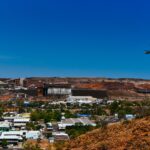Mining has played an integral role in the development of the Mount Isa community, whose population is now at around 22,000 people.
An Ore-some Discovery:
John Campbell Miles is credited with the discovery of the ores of Mount Isa in 1923. The same area had already been prospected for many years, but most prospectors had been preoccupied looking for copper or gold.

Miles sent some specimens of the black and grey minerals he’d found to nearby Cloncurry for assessment by the Government Assayer. They found the samples contained large amounts of lead and silver. Miles had unwittingly stumbled upon what would become one of the world’s most productive mines.
After Miles’ important discovery, he pegged out a lease in the area across 42 acres of land, and in 1924, Mount Isa Mines Ltd was established: the most isolated mine in Australia in terms of its distance from the sea and coal fields.
One illustration of the perils of this distance occurred in 1927, when an injured miner was transported to Cloncurry Hospital by plane. This event, which clearly demonstrated the miners’ lack of access to sufficient health care, was the deciding factor in trialling the Australian Inland Mission’s Aerial Medical Service the following year. The need for this service in the outback was clear, and it is still in operation today – known as the Royal Flying Doctor Service of Australia.
In the early days after Miles’ discovery, there were doubts as to whether it would be a profitable site. However in 1930, drilling estimated reserves of 32 million tons of lead-zinc ore. That same year, it was discovered that the mine contained a very good grade of copper mineralisation, but Mount Isa Metals Ltd did not have the financial resources to develop copper until many years later. Interestingly, the Mount Isa Mines have now become Australia’s second largest producer of copper.
From Mount Isa to the world:
Due to the complexity of extracting the Mount Isa ore bodies, the mines have needed to be mechanised from the very beginning. Instead of using hand drilling and hand shovels as was common practice back in the 20s and 30s, the process was mechanised to a degree not previously known of in Australia.
As the Mount Isa Mines have always needed to be on the forefront of technology, this has led to the development of a number of technologies now used in other mines around the world. Examples include ISASMELT™ (developed with the CSIRO), IsaMill, and IsaKidd, considered to be the preferred copper refining technology in the world.
Mount Isa Mines community:
In the 50s post World War II, an influx of immigrants settled in Mount Isa, keen to build new lives in the country they now called home. They were welcomed into the flourishing mining community and Mount Isa’s community remains culturally diverse today.

As for what became of prospector John Campbell Miles, he sold his leases in 1924 for a mere £10,000. He went on to prospect in Northern Territory and Victoria, and sold the last of his shares in 1933. He died at age 82, and his ashes have been interred under the clock tower on Miles Street in Mount Isa.
The Mount Isa Mines were acquired by Glencore in 2013. The mines reportedly provide jobs for over 20% of Mount Isa’s population.



